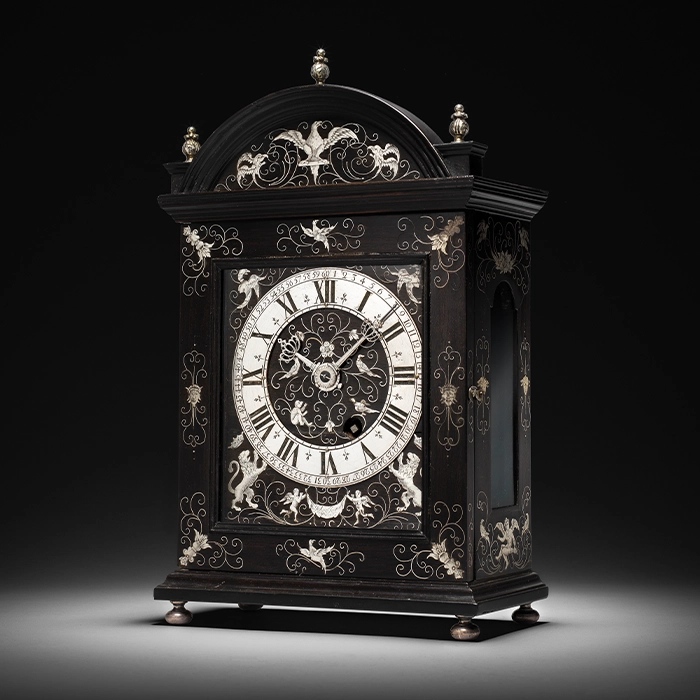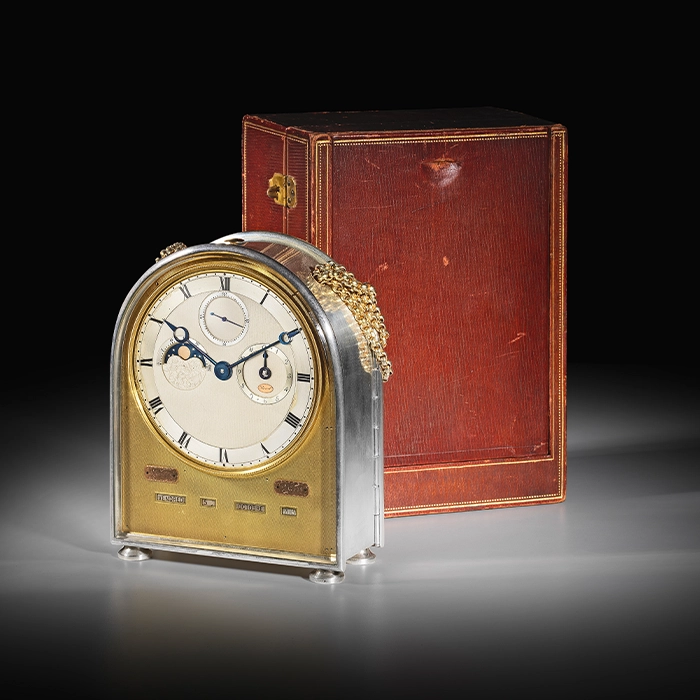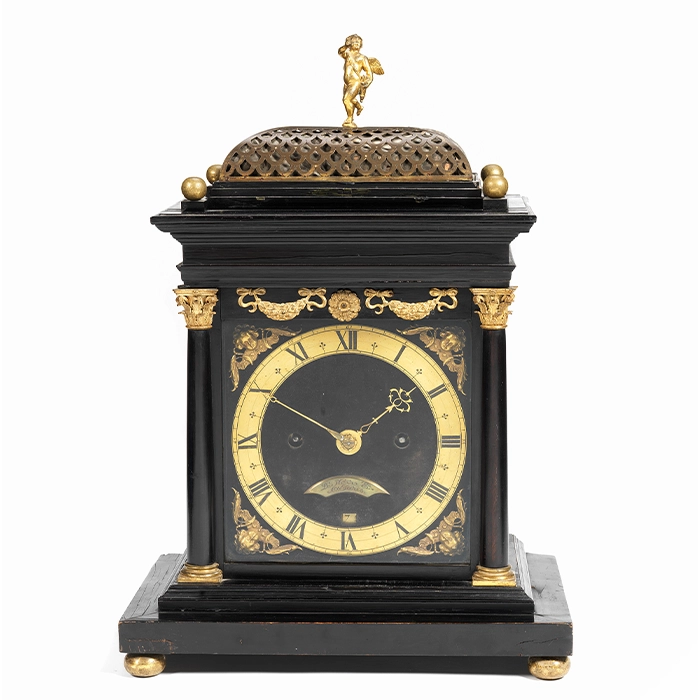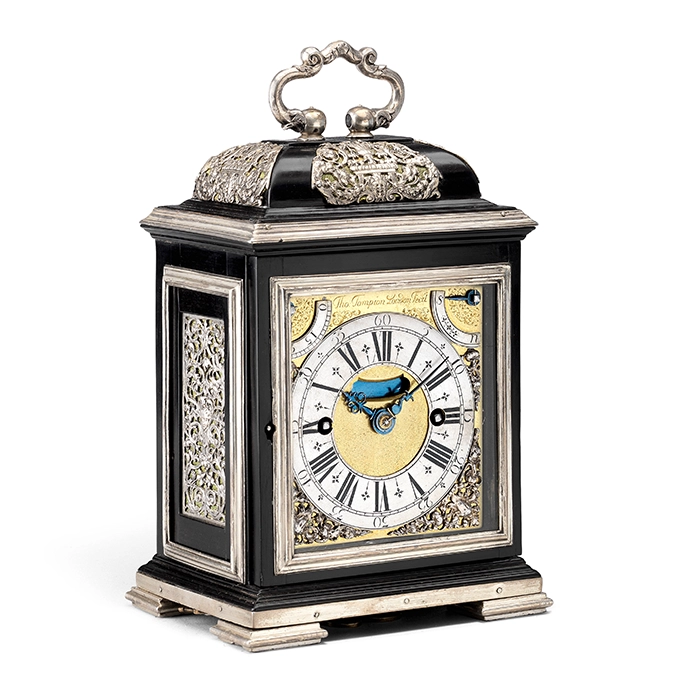28 January 2025
Clocks: The beating heart of your home
8 minutes
Bonhams Director of Fine Clocks, James Stratton, is the only professionally qualified valuer of clocks in the auction world and he shares his unrivalled understanding of the market with Client Director Julie Webb
The thought that by simply turning a key in an antique clock I can hear the same sound that someone else heard several centuries ago never fails to thrill me. It is one of the reasons that sets clock ownership apart from so many other collectible areas – without you, the clock will not tick.
Framed art is wonderful to look at but requires no personal input once they are hung. Our clients look forward to the weekly ritual of winding - to coin a modern phrase, it is a moment of mindfulness in a busy world. And of course, once a clock is running it becomes the beating heart of a home.
|
|
Clocks often have a story to tell, too. One of the most striking examples in our last auction was a fine and rare late 17th century French silver-inlaid ebony ‘Pendule Religieuse’ clock made in France by an Englishman, John Joyne, in about 1680. Joyne led an eventful life, starting in London, but spending the 1670s in Paris. Europe in the second half of the 17th century was a melee of political intrigue and on his return to London, Joyne became involved in clearing the name of the diarist, Samuel Pepys. The clock itself is exquisite, elaborately inlaid in silver scrolls with a host of mythical beasts. It is a beautiful piece made by an accomplished clockmaker with a compelling past. (Image: A fine and very rare late 17th century French silver-inlaid ebony. Credit: Bonhams) |
The importance of provenance
The provenance of a clock is becoming more and more important. 10-plus years ago, when we sold more than 500 clocks a year, I would be asked perhaps half a dozen times about where a clock came from. Now it is with almost every lot.
Where a clock has been inherited, it is unlikely the vendor will know much of its history, but I always try to give as much information as I can in our catalogues, even it if it is just ‘Single-family ownership since 1964’ for example. Such information quickly shows that the clock has not been through a dealer’s hands in the recent past and that it is ‘fresh’ to the market.
|
|
Sometimes the provenance of a clock can give me goosebumps. Some years ago, Bonhams sold a marine chronometer from the ship HMS Beagle. It was the personal property of Captain Robert FitzRoy, and accompanied him and the young Charles Darwin on their five-year voyage between 1831 and 1836. So crucial were chronometers to the running of the voyage, that 22 were taken, and this one was recorded in performance reports as having been ‘rather good’. To wonder if Darwin ever wound it is one of the reasons I love my work so much. Likewise, last year, we sold an exceptional Breguet clock that was commissioned by Ettore Bugatti, the legendary Italian-born French car designer and manufacturer. To think this clock would have been a constant companion to Bugatti is very special indeed. (Image: An important second quarter of the 19th century marine chronometer used on the second votage of HMS beagle and subsequently for the North American Boundary Expedition. W.E. Frodsham, London, Number two. Credit Bonhams) |
Bugatti transformed the world of motoring, and it was only natural that he went to the equally driven firm of clockmakers, Breguet of Paris, to purchase one of the most complex domestic timepieces of the period. This was a once-in-a-lifetime opportunity to acquire an object steeped in both automative and horological history. It was no surprise that the clock sold for more than £216,000.
|
(Image: Breguet No. 759. A very fine silver hump-backed carriage clock with perpetual calendar, moonphase, grande sonnerie striking and alarm. Sold to Ettore Bugatti in 1931. Credit: Bonhams) |
The Cupid Fromanteel
Another highlight was the discovery and subsequent naming of 'The Cupid Fromanteel' table clock. The introduction by Ahasuerus Fromanteel of the pendulum into Britain in 1658 brought in a new era of precision timekeeping. His early clocks are incredibly rare, but one famous example is illustrated on the back cover of the standard reference work ‘Early English Clocks’. It has a distinctive pierced brass dome mounted with a figure of Chronos, the god of time, standing on top of it.
|
|
One afternoon I opened an email from one of my European colleagues – it showed an identical clock except that it had a figure of cupid standing on top. I couldn’t believe my eyes – it had to be by the same maker. I rang my colleague immediately and asked them to send it to London – it arrived within days and as soon as I began to unwrap the sheeting, the hairs on the back of my neck let me know that this was the real thing. Everything was ‘right’ about it – the colour of the mounts, the patination of the case, the feel of the brass, the cut of the wheels inside. It was like opening a pair of curtains to find the original Mona Lisa behind them. The owner had contacted us because she wanted to raise 10,000 euros to install a sauna in her home. The pre-sale estimate was £200,000-300,000 and it outstripped even that to sell for £692,000 on the day. (Image: A highly important, recent discovered English ebony bracket clock attributable to Ahasuerus Fromanteel. Credit: Bonhams) |
Tompion and the Golden Age
There are lots of different aspects to the clock market, but one area that continues to do well is the so-called ‘Golden Age’. This era spans the 50 years after Fromanteel’s introduction of the pendulum, circa 1658-1710. The earlier examples tend to be more experimental and therefore interesting to collectors.
Almost all makers of note at this time were based in London, and the most highly regarded of these is Thomas Tompion. The finest of his clocks were ordered by Royalty, often to be used as diplomatic gifts, but he also supplied ‘ordinary’ house clocks for the very wealthy. One of these today will start at about £150,000 at auction. Such was his reputation that on his death in 1713, he was buried in Westminster Abbey.
Bonhams is the auction world record-holder for the sale of a Tompion clock. It was made for Queen Mary, wife of King William, in 1692, and stands just a little bigger than a mobile phone. With exquisite silver mounts featuring the royal Lion and Unicorn, it sold in London for just under £2 million to a private UK collector.
|
(Image: A highly important late 17th century silver mounted ebony striking and quarter repeating miniature clock with royal provenance. Known as the ‘Q’ click, the smallest ebony cased clock by Tomas Tompion in the world. Credit: Bonhams) |
There are many reasons why collectors value Tompion’s work so highly – one is for the sheer excellence of the design and construction. The quality control within his workshop was akin to the world’s finest restaurants where no expense was spared in the sourcing, preparation and combining of the materials. His case veneers were so carefully chosen, his hands beautifully hand-cut and mounted in a unique manner, his steel more highly finished, his brass more refined, his pinions always perfectly cut – every part the very best it could be and the sum is much greater than the individual parts. After about 1685, Tompion began numbering his clocks and this gives buyers a lot of confidence today. There are several lists of known Tompion clock numbers so we gain a lot of information on the history of individual clocks. However, the list is far from complete and this is another dream, to find a previously unrecorded example. Contemporaries of Tompion that are also strong in the market include Joseph Knibb, Christopher Gould, Henry Jones, Edward East, Ahasuerus Fromanteel and, a little later, Tompion’s apprentice George Graham. |
No Capital Gains Tax
Remember, you do not pay Capital Gains Tax on clocks as they are classed as a personal possession with a lifespan of less than 50 years. This UK Government exemption covers all machinery including antique clocks.
Who is buying?
Our buyers are predominantly British and American, but the Asian market is growing, particularly for the 20th century products of Patek Philippe and Jaeger-LeCoultre. 19th century novelty clocks such as those in the form of objects or buildings with moving parts such as a windmill with turning sails, a lighthouse with a rotating top or a car with moving wheels are also performing well on the international market.
Top buying tips
- Always buy a clock because you want to own it rather than for speculative profit. A clock is something that you will interact with every time you enter the room, so make sure you like the way it looks.
- View as many clocks as you can, either at specialist auctions, dealers or antique fairs. Before you buy, ask questions such as:
- Does it work fully as it should (remember the more complicated a clock is, the more expensive it will be to repair).
- What restoration has it undergone in the past?
- Do they know who carried out the work and when?
- Are the case, dial, and movement all original to one another?
- Do you know where it has come from – is there any known provenance?
About James Stratton MRICS
James became interested in antiques as a child when his parents ‘dragged’ him and his two brothers around antique shops. After A levels he studied the Fine Arts and Chattels course of The Incorporated Society of Valuers and Auctioneers (later merged with the Royal Institute of Chartered Surveyors).
He joined Bonhams’ clock department in 1993 and has since sold some of the finest clocks to have come onto the open market in the last three decades.
James is a Liveryman and past Steward of the Worshipful Company of Clockmakers and has served on the council of the Antiquarian Horological Society since 2016.
Every year James sponsors the ‘Dingwall Beloe’ lecture at the British Museum, a highlight event for private collectors.
Visit bonhams.com
Insurance and valuations
Whether you are a long-term collector or new to buying clocks, these examples of high values highlight the importance of regular valuations and insurance.
Insurers recommend that you obtain a valuation at least every five years, preferably three in today’s market. But check your schedule and policy wording for specific requirements.
Insurers will require any valuation to be for “insurance purposes” and usually for retail value. You should also consider how you would replace your clock in the event of a loss. Would you want a new replacement with a modern equivalent (New Replacement Value) or would you prefer an antique replacement (Antique Replacement Value)?
Ensure the items are photographed, kept in good condition and your documentation is in a safe place to help in the event of a claim.
It’s a good idea to send a copy of your valuations to your broker, whether or not the insurer requires it.
To speak to us about your insuring your collectible call 020 8256 4901 or email privateclients@howdeninsurance.co.uk





